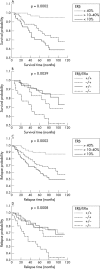The favourable prognostic value of oestrogen receptor beta immunohistochemical expression in breast cancer
- PMID: 15113861
- PMCID: PMC1770285
- DOI: 10.1136/jcp.2003.008599
The favourable prognostic value of oestrogen receptor beta immunohistochemical expression in breast cancer
Abstract
Aims: Oestrogen receptor beta (ERbeta) is present in breast tumours, although its prognostic and pathophysiological roles remain to be established.
Methods: Standard immunohistochemistry with a specific monoclonal antibody was performed on paraffin wax embedded sections; 10% of strongly immunostained carcinoma cells was used as the cutoff point to classify tumours as ERbeta positive. Statistical correlations were sought with clinicopathological variables (including hormone receptor status) and disease free (DFS) and overall survival (OS) in a well documented series of 181 invasive breast carcinomas. Cell proliferation was assessed immunohistochemically by topoisomerase IIa (TopoIIa) index; p53 protein accumulation and c-erbB-2 oncoprotein expression were also taken into account.
Results: ERbeta immunoreactivity was detected in most specimens (71.2%); it was positively linked to ERalpha immunoreactivity and increased TopoIIalpha index, and inversely to c-erbB-2 overexpression. There were no correlations with p53 immunostaining or other clinicopathological parameters. A significant favourable impact of ERbeta immunopositivity emerged with regard to DFS and OS in both univariate and multivariate analysis; ERbeta immunopositivity retained its favourable significance with regard to DFS in the subgroups of stage I and II patients when they were examined separately. Progesterone receptor expression also had an independent favourable influence on survival, albeit with less significance. In contrast, survival was not significantly influenced by ERalpha status.
Conclusions: Because of the positive association between ERbeta immunoreactivity and TopoIIalpha expression, the presence of ERbeta in breast cancer cells could be considered an indication of increased proliferation. Nevertheless, ERbeta immunoreactivity emerges as a valuable, independent indicator of favourable prognosis.
Figures




References
-
- Fitzgibbons PL, Page DL, Weaver D, et al. Prognostic factors in breast cancer. College of American Pathologists’ Consensus Statement 1999. Arch Pathol Lab Med 2000;124:966–78. - PubMed
-
- Harvey JM, Clark GM, Osborne CK, et al. Estrogen receptor status by immunohistochemistry is superior to the ligand-binding assay for predicting response to adjuvant endocrine therapy in breast cancer. J Clin Oncol 1999;17:1474–81. - PubMed
Publication types
MeSH terms
Substances
LinkOut - more resources
Full Text Sources
Medical
Research Materials
Miscellaneous
